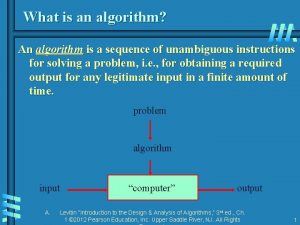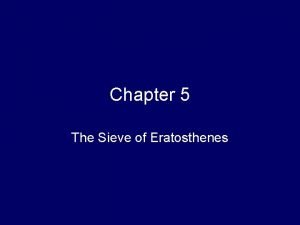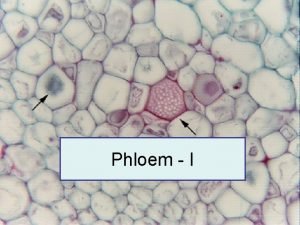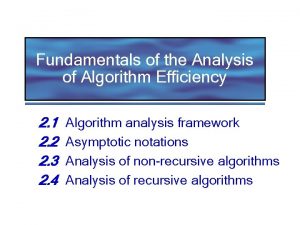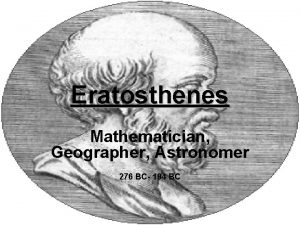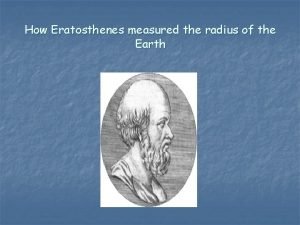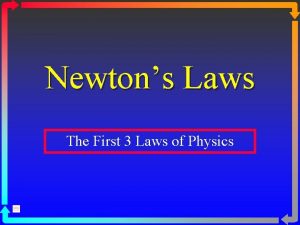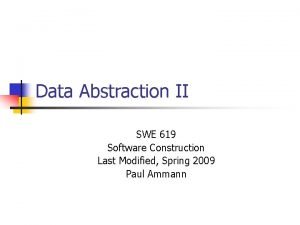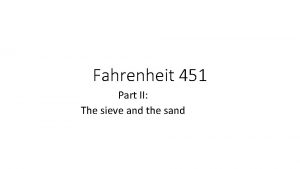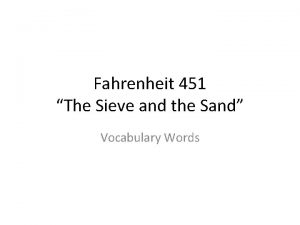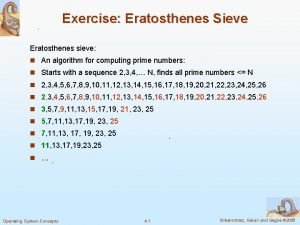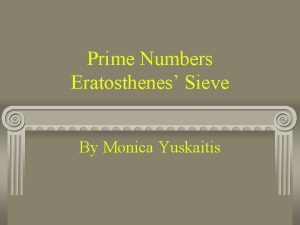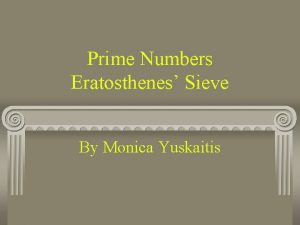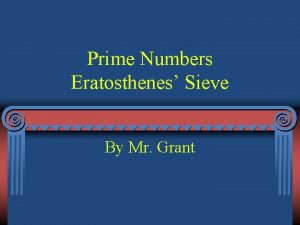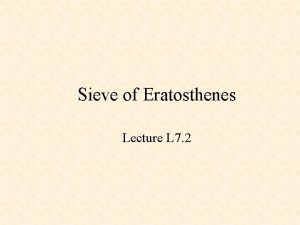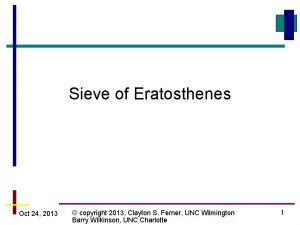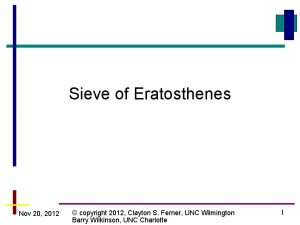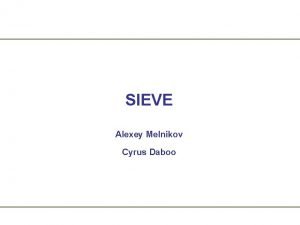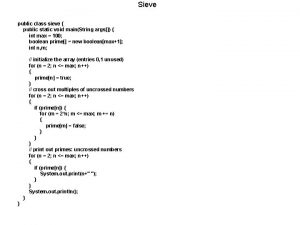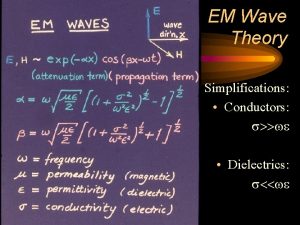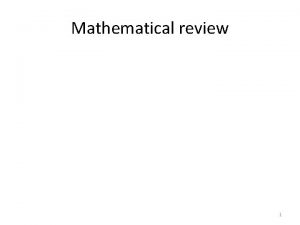Mathematical Algorithms SWE 2016 44 Sieve of Eratosthenes

























![Matrix Chain Multiplication Given an array p[] which represents the chain of matrices such Matrix Chain Multiplication Given an array p[] which represents the chain of matrices such](https://slidetodoc.com/presentation_image_h2/072e7b900d9bd336fec6900205661f83/image-26.jpg)




- Slides: 30

Mathematical Algorithms SWE 2016 -44

Sieve of Eratosthenes Given a number n, print all primes smaller than or equal to n. It is also given that n is a small number. Example: 2

Sieve of Eratosthenes Algorithm: 1) Create a list of consecutive integers from 2 to n: (2, 3, …, n). 2) Initially, let p equal 2, the first prime number. 3) Enumerate the multiples of p by counting in increments of p from 2 p to n, and mark them in the list (2 p, 3 p, 4 p, . . . ). 4) Find the first number greater than p in the list that is not marked. If there was no such number, stop. Otherwise, let p now equal this new number (the next prime), and repeat from step 3. 5) When the algorithm terminates, the numbers remaining not marked in the list are all the primes below n. 3

Sieve of Eratosthenes https: //en. wikipedia. org/wiki/Sieve_of_Eratosthenes 4

Sieve of Eratosthenes https: //en. wikipedia. org/wiki/Sieve_of_Eratosthenes 5

Sieve of Eratosthenes 6

Sieve of Eratosthenes • 7

Finding all prime factors of a given number Given a number n, write an efficient function to print all prime factors of n. For example, if the input number is 12, then output should be “ 2 2 3”. And if the input number is 315, then output should be “ 3 3 5 7”. 8

Finding all prime factors of a given number Algorithm 1: 1) While n is divisible by 2, print 2 and divide n by 2. 2) After step 1, n must be odd. Now start a loop from i = 3 to square root of n. While i divides n, print i and divide n by i. After i fails to divide n, increment i by 2 and continue. 3) If n is a prime number and is greater than 2, then n will not become 1 by above two steps. So print n if it is greater than 2. 9

Finding all prime factors of a given number Algorithm 1: à Time Complexity: 10

Finding all prime factors of a given number Algorithm 2: 1) To calculate to smallest prime factor for every number we will use the sieve of eratosthenes. In original Sieve, every time we mark a number as not-prime, we store the corresponding smallest prime factor for that number. 2) After we are done with precalculating the smallest prime factor for every number we will divide our number n by its corresponding smallest prime factor till n becomes 1. 11

Finding all prime factors of a given number Algorithm 2: à Time Complexity: O(log(n)) 12

Finding GCD or HCF of two numbers GCD (Greatest Common Divisor) or HCF (Highest Common Factor) of two numbers is the largest number that divides both of them. For example GCD of 20 and 28 is 4 and GCD of 98 and 56 is 14. 13

Finding GCD or HCF of two numbers 1) A simple solution: find all prime factors of both numbers, then find intersection of all factors present in both numbers. Finally return product of elements in the intersection. 14

Finding GCD or HCF of two numbers 2) An efficient solution: use Euclidean algorithm which is the main algorithm used for this purpose. The idea is, GCD of two numbers doesn’t change if smaller number is subtracted from a bigger number. 15

Finding GCD or HCF of two numbers 2) An efficient solution: 16

Finding GCD or HCF of two numbers 3) A more efficient solution: use modulo operator in Euclidean algorithm 17

Finding GCD or HCF of two numbers 3) A more efficient solution (Euclidean Algorithm): Time Complexity: O(Log min(a, b)) 18

Finding GCD or HCF of two numbers Example: Find the GCD of 270 and 192 Method 2: GCD(270, 192) GCD(192, 78) GCD(114, 78) GCD(78, 36) GCD(42, 36) GCD(36, 6) GCD(6, 0) Method 3: GCD(270, 192) GCD(192, 78) GCD(78, 36) GCD(36, 6) GCD(6, 0) 19

Finding GCD or HCF of two numbers Extended Euclidean Algorithm ax + by = gcd(a, b) Examples: 20

Finding GCD or HCF of two numbers Extended Euclidean Algorithm The extended Euclidean algorithm updates results of gcd(a, b) using the results calculated by recursive call gcd(b%a, a). Let values of x and y calculated by the recursive call be x 1 and y 1. x and y are updated using the below expressions. 21

Finding GCD or HCF of two numbers Extended Euclidean Algorithm Time Complexity: O(Log min(a, b)) 22

Matrix Chain Multiplication Given a sequence of matrices, find the most efficient way to multiply these matrices together. The problem is not actually to perform the multiplications, but merely to decide in which order to perform the multiplications. 23

Matrix Chain Multiplication We have many options to multiply a chain of matrices because matrix multiplication is associative. In other words, no matter how we parenthesize the product, the result will be the same. For example, if we had four matrices A, B, C, and D, we would have: 24

Matrix Chain Multiplication However, the order in which we parenthesize the product affects the number of simple arithmetic operations needed to compute the product, or the efficiency. For example, suppose A is a 10 × 30 matrix, B is a 30 × 5 matrix, and C is a 5 × 60 matrix. Then, 25
![Matrix Chain Multiplication Given an array p which represents the chain of matrices such Matrix Chain Multiplication Given an array p[] which represents the chain of matrices such](https://slidetodoc.com/presentation_image_h2/072e7b900d9bd336fec6900205661f83/image-26.jpg)
Matrix Chain Multiplication Given an array p[] which represents the chain of matrices such that the ith matrix Ai is of dimension p[i-1] x p[i]. We need to write a function Matrix. Chain. Order() that should return the minimum number of multiplications needed to multiply the chain. 26

Matrix Chain Multiplication Recursive Implementation 27

Matrix Chain Multiplication Overlapping Subproblems 28

Matrix Chain Multiplication Dynamic Programming Time Complexity: O(n 3) 29

Reference • Charles Leiserson and Piotr Indyk, “Introduction to Algorithms”, September 29, 2004 • https: //www. geeksforgeeks. org • https: //en. wikipedia. org/wiki
 Algorithm of sieve of eratosthenes
Algorithm of sieve of eratosthenes Sieve of eratosthenes parallel
Sieve of eratosthenes parallel Sieve tubes
Sieve tubes Measuring algorithm efficiency
Measuring algorithm efficiency Elements of mathematical economics
Elements of mathematical economics Eratosthenes and aristarchus
Eratosthenes and aristarchus Eratosthenes ap human geography
Eratosthenes ap human geography Eratosthenes astronomy contributions
Eratosthenes astronomy contributions Eratosthenes solar system
Eratosthenes solar system Eratosthenes biography
Eratosthenes biography Eratosthenes assumptions
Eratosthenes assumptions Jeff offutt
Jeff offutt ßwe
ßwe Swe 619
Swe 619 Glass av kvarg
Glass av kvarg Swe 619 gmu
Swe 619 gmu Swe 619
Swe 619 Swe exam sample
Swe exam sample Swe 432
Swe 432 Swe 619 gmu
Swe 619 gmu Finance committee presentation
Finance committee presentation Swe 432
Swe 432 What is this image
What is this image Swe mission statement
Swe mission statement Ballast sieve analysis format
Ballast sieve analysis format Fahrenheit 451 the sieve and the sand questions
Fahrenheit 451 the sieve and the sand questions Uniformly graded soil graph
Uniformly graded soil graph Sieve tube members
Sieve tube members Fahrenheit 451 part 2 vocabulary
Fahrenheit 451 part 2 vocabulary Phloem
Phloem Excess heat reduce
Excess heat reduce
